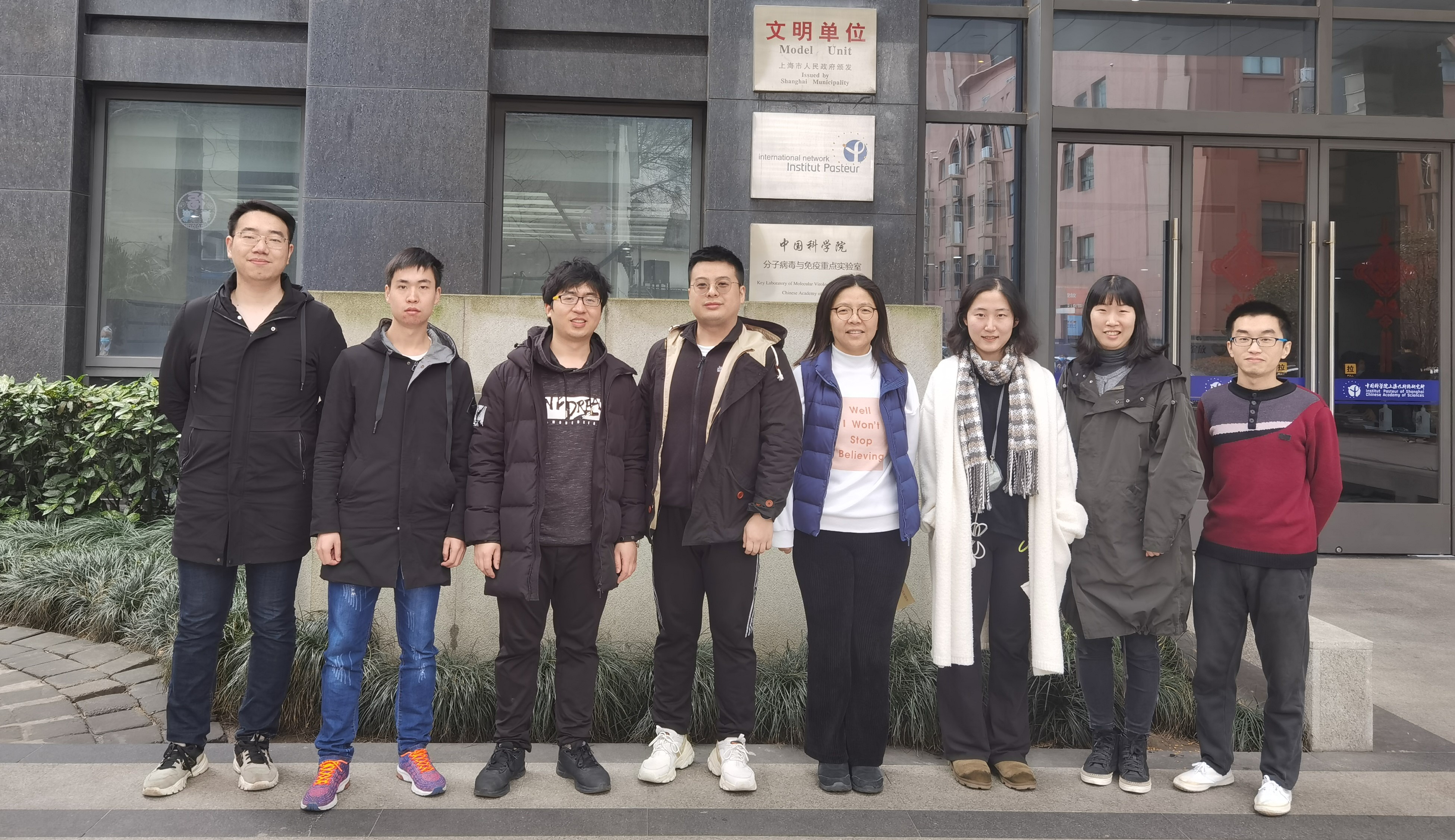
| Name: | Pei HAO | Gender: | |
|---|---|---|---|
| Education: | |||
| Academic degree: | Ph.D. | Academic title: | Principal Investigator |
| Departments: | The Lab for Pathogen Big Data | Discipline: | Bioinformatics |
| Phone: | 021-54923165 | E-mail: | phao@ips.ac.cn |
| Mailing Address: | Life Science Research Building, 320 Yueyang Road, Xuhui District, 200031 | ||
| Curriculum vitae: |
|---|
2021-Present: Professor, Principle Investigator, Institute Pasteur of Shanghai, Chinese Academy of Sciences; 2012-2020: Professor, Bioinformatics Platform, Institute Pasteur of Shanghai, Chinese Academy of Sciences; 2008-2011: Associate professor, Key Laboratory of Systems Biology, CAS; 2006-2014: Principle Investigator, Shanghai Center for Bioinformation Technology; 2003-2006: Director, SCBIT-IBM-Inforsense-joint Laboratory, Shanghai Center for Bioinformation Technology; 2000-2007: General Project Manager, Shanghai Information Center for Life Sciences, CAS; 1997-2000: Software Engineer, Shanghai Information Center for Life Sciences, CAS. |
| Research direction: |
|---|
|
l Aims to establish a pathogenic big data platform based on viral genomes screening of the environments. This platform is expected to perform a real-time surveillance of the urban environmental genomes, to evaluate the risks of the potential pathogens and finally provide early warning of the emerging/re-emerging infectious diseases, as well as the severe chronic infectious diseases. l The development of new algorithm for the molecular evolutionary analysis of virus, the network modeling of viral pathogenicity, and the molecular dynamics simulations to evaluate the spread of the virus in the host. l To address the challenge of big data in life science, develop a series of methods for the multi-dimensional omics-data analysis and their applications.
|
| Research progress: |
|---|
|
1. Zechuan Chen, Zeruo Yang, Xiaojun Yuan, Xiaoming Zhang, Pei Hao . scSensitiveGeneDefine: sensitive gene detection in single-cell RNA sequencing data by Shannon entropy. BMC Bioinformatics. 2021 Apr 22;22(1):211. doi: 10.1186/s12859-021-04136-1. 2. Wang J, Xu X, Zhou X, Chen P, Liang H, Li X, Zhong W, Hao P. Molecular simulation of SARS-CoV-2 spike protein binding to pangolin ACE2 or human ACE2 natural variants reveals altered susceptibility to infection. J Gen Virol. 2020 Jun 15. doi: 10.1099/jgv.0.001452. Online ahead of print. PMID: 32538738 3. Zhang N, Jing X, Liu Y, Chen M, Zhu X, Jiang J, Wang H, Li X*, Hao P*. Interfering with retrotransposition by two types of CRISPR effectors: Cas12a and Cas13a. Cell Discov. 2020 May 19;6:30. doi: 10.1038/s41421-020-0164-0. eCollection 2020.PMID: 32435507. 4. Hao P, Zhong W, Song S, Fan S, Li X. Is SARS-CoV-2 originated from laboratory? A rebuttal to the claim of formation via laboratory recombination. Emerg Microbes Infect. 2020 Mar 8;9(1):545-547. doi: 10.1080/22221751.2020.1738279. eCollection 2020. PMID: 32148173 5. Yuan J, Chang SY, Yin SG, Liu ZY, Cheng X, Liu XJ, Jiang Q, Gao G, Lin DY, Kang XL, Ye SW, Chen Z, Yin JA, Hao P, Jiang L, Cai SQ. Two conserved epigenetic regulators prevent healthy ageing. Nature. 2020 Feb 26. doi: 10.1038/s41586-020-2037-y. 6. Xu X, Chen P, Wang J, Feng J, Zhou H, Li X, Zhong W, Hao P. Evolution of the novel coronavirus from the ongoing Wuhan outbreak and modeling of its spike protein for risk of human transmission. Sci China Life Sci. 2020 Mar;63(3):457-460. doi: 10.1007/s11427-020-1637-5. 7. Ye Y, Liu M, Tang L, Du F, Liu Y, Hao P, Fu Q, Guo Q, Yan Q, Zhang X, Bao C. Iguratimod represses B cell terminal differentiation linked with the inhibition of PKC/EGR1 axis. Arthritis Res Ther. 2019 Apr 11;21(1):92. doi: 10.1186/s13075-019-1874-2. 8. Qian W, Ma T, Ye M, Li Z, Liu Y, Hao P. Microbiota in the apical root canal system of tooth with apical periodontitis. BMC Genomics. 2019 Apr 4;20(Suppl 2):189. doi: 10.1186/s12864-019-5474-y. 9. Wan X, Liu L, Zhou P, Hui X, He Q, Yu F, Zhang W, Ding X, Yuan X, Zhang N, Zhao Y, Zhu R, Liu Y, Hao P, Auwerx J, Song X, Leng Q, Zhang Y. The nuclear receptor corepressor NCoR1 regulates hematopoiesis and leukemogenesis in vivo. Blood Adv. 2019 Feb 26;3(4):644-657. doi: 10.1182/bloodadvances.2018022756. 10. Chen P, Jing X, Ren J, Cao H, Hao P, Li X. Modelling BioNano optical data and simulation study of genome map assembly. Bioinformatics. 2018 Dec 1;34(23):3966-3974. doi: 10.1093/bioinformatics/bty456. 11. Chen X, Zhao J, Gu C, Cui Y, Dai Y, Song G, Liu H, Shen H, Liu Y, Wang Y, Xing H, Zhu X, Hao P, Guo F, Liu X. Med23 serves as a gatekeeper of the myeloid potential of hematopoietic stem cells. Nat Commun. 2018 Sep 14;9(1):3746. doi: 10.1038/s41467-018-06282-2. PMID: 30218073 12. Cao Y, Cao R, Huang Y, Zhou H, Liu Y, Li X, Zhong W, Hao P. A comprehensive study on cellular RNA editing activity in response to infections with different subtypes of influenza a viruses. BMC Genomics. 2018 Jan 19;19(Suppl 1):925. doi: 10.1186/s12864-017-4330-1. 13. Huang Y, Cao Y, Li J, Liu Y, Zhong W, Li X, Chen C, Hao P. A survey on cellular RNA editing activity in response to Candida albicans infections. BMC Genomics. 2018 Jan 19;19(Suppl 1):43. doi: 10.1186/s12864-017-4374-2. 14. Cao Y, Huang Y, Xu K, Liu Y, Li X, Xu Y, Zhong W, Hao P. Differential responses of innate immunity triggered by different subtypes of influenza a viruses in human and avian hosts. BMC Med Genomics. 2017 Dec 21;10(Suppl 4):70. doi: 10.1186/s12920-017-0304-z. 15. Yu Y, Zhou H, Kong Y, Pan B, Chen L, Wang H, Hao P#, Li X#.The Landscape of A-to-I RNA Editome Is Shaped by Both Positive and Purifying Selection. PLoS Genet. 2016 Jul 28;12(7):e1006191. 16. Yimeng Kong, Hongxia Zhou, Yao Yu, Longxian Chen, Pei Hao#, Xuan Li# The evolutionary landscape of intergenic trans-splicing events in insects. Nat Commun. 2015 Nov 2;6:8734. 17. Hu Y*, Lu S*, Song Z*, Wang W*, Hao P*, Li J, Zhang X, Yen HL, Shi B, Li T, Guan W, Xu L, Liu Y, Wang S, Zhang X, Tian D, Zhu Z, He J, Huang K, Chen H, Zheng L, Li X, Ping J, Kang B, Xi X, Zha L, Li Y, Zhang Z, Peiris M, Yuan Z. Association between adverse clinical outcome in human disease caused by novel influenza A H7N9 virus and sustained viral shedding and emergence of antiviral resistance. Lancet 2013; 381(9885):2273-9. 18. Gao R, Cao B, Hu Y, Feng Z, Wang D, Hu W, Chen J, Jie Z, Qiu H, Xu K, Xu X, Lu H, Zhu W, Gao Z, Xiang N, Shen Y, He Z, Gu Y, Zhang Z, Yang Y, Zhao X, Zhou L, Li X, Zou S, Zhang Y, Li X, Yang L, Guo J, Dong J, Li Q, Dong L, Zhu Y, Bai T, Wang S, Hao P, Yang W, Zhang Y, Han J, Yu H, Li D, Gao GF, Wu G, Wang Y, Yuan Z, Shu Y. Human infection with a novel avian-origin influenza A (H7N9) virus. N Engl J Med 2013; 368(20):1888-97. 19. Chinese SARS Molecular Epidemiology Consortium. Molecular evolution of the SARS coronavirus during the course of the SARS epidemic in China. Science 2004;303(5664):1666-9. 20. Feng Q*, Zhang Y*, HaoP*, etc al. Sequence and analysis of rice chromosome 4. Nature 2002; 420(6913):316-20. |
| Laboratory members: |
|---|
Lab members Research Associate/Assistant: Shiyang Song Postdoctoral Fellow: Ping Chen. Ph.D. Ph. D. Candidates: Kai Liu; Liang Ou; Xintian Xu; Ouyang Mo, Rui Li
|
